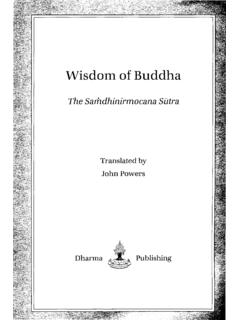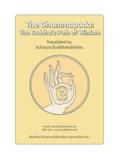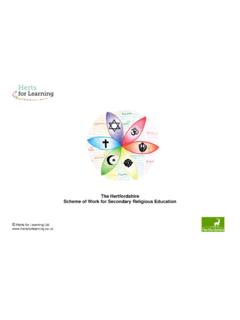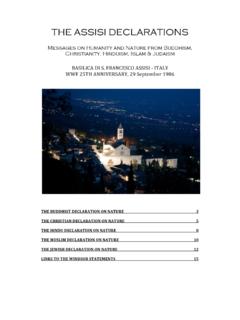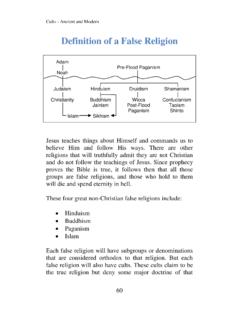Transcription of A Tree in a Forest - The Teachings of Ajahn Chah
1 A TreeinA ForestA C A C S C E D G T G Y K P H Y K T Y J H F F D F F D Offer the gift of Dhamma to others as freely as it has been offered to the wish of Ajahn Chah that his Dhamma Teachings not be sold in any way or form, this book is published for free distribution only. Copyright Dhamma Garden 1994 First Printing 1994 All rights reserved. Any reproduction, in whole or part, in any form, for sale, profit or gain, is prohibited. However, copies of this book, or permission to reprint for free distribution, may be obtained upon notification from:Yuan Kuang Publishing HouseNo. 11, Lane 888, Sect. 1, San Ter RoadChungli, Taiwan, in Taiwan, Republic of ChinaISBN 957-8895-05-0vPeople have asked about my practice.
2 How do I prepare my mind for meditation? ere is nothing special. I just keep it where it always is. ey ask, en are you an arahant? Do I know? I am like a tree in a Forest , full of leaves, blossoms and fruit. Birds come to eat and nest, and animals seek rest in its shade. Yet the tree does not know itself. It follows its own nature. It is as it C vAjahn ChahAjahn Chah was born in 1918 in a village located in the north-eastern part of ailand. He became a novice at a young age and received higher ordination at the age of twenty. He followed the austere Forest Tradition for years, living in forests and begging for almsfood as he wandered about on mendicant practised meditation under a number of masters, among whom was Ajahn Mun, a highly respected and accomplished medita-tion teacher of the time.
3 Ajahn Mun had an indelible influence on Ajahn Chah, giving his meditation practice the direction and clarity that it lacked. Ajahn Chah later became an accomplished meditation teacher in his own right, sharing his realization of the Dhamma with those who sought it. e essence of his teaching was rather simple: be mindful, don t hang on to anything, let go and surrender to the way things Chah passed away in peace after a long bout of illness on January 16, 1992, at his home monastery, Wat Pah Pong, in Ubon more information on books on Ajahn Chah write to:Wat Pah Nanachat, Bahn Bung Wai, Warinchamrab, Ubol Rajathani, s NoteDue to popular demand, we have decided to separate the English and Mandarin parts of the original bilingual publications of A Tree in a Forest , Vols.
4 I & II, and publish them under separate covers. Each new language edition has been divided into two parts: Part I consists of the 75 similes that appeared in the first volume of A Tree in a Forest , and Part II consists of the 108 similes that appeared in the second e Teachings of Ajahn Chah were originally made available to the English-speaking public by the efforts of his Western disciples who were able to translate from ai or Lao, the languages that Ajahn Chah taught in. Although for some time now these English publica-tions have been circulating in Chinese-speaking communities, partic-ularly in Singapore and Malaysia, and more recently in Taiwan, they have remained accessible only to those with an adequate knowledge of the English language.
5 Ese readers, inspired by Ajahn Chah s teach-ings, have often expressed regret that those among their compatriots with little or no knowledge at all of English shouldn t have the chance to benefit from the wisdom of Ajahn Chah s words. For this reason, a joyfully willing and dedicated group made up of members from both the Buddhist monastic community and laity, decided to translate the works of Ajahn Chah. ey come from Taiwan, Hong Kong, Singapore and Malaysia, and all are blessed with the facility to work in both the English and Chinese languages. Also, and more importantly, they all have adequate experience and understanding of the Dhamma coupled with the feel and genuine appreciation of Ajahn Chah s Teachings .
6 It is a credit to their goodness and sincere wish to spread the Dhamma in whatever way they can, that this work is now in your would like to acknowledge gratitude to all who took part in any aspect of the production of this book, be it designing, proofread-ing, copying, contributing toward the cost of its printing, and so on. May the Light of the Triple Gem continue to shine in their hearts and give them the peace and happiness they will note that no one s name has been mentioned and none given any special credit. is is just a way of following Ajahn Chah s teaching of not trying to be anything: not an arahant, not a bodhi-satta, not even a viviiTranslators NoteIt is said that if a person should find a bright star, he has no right to put it into his pocket and keep the light all to himself, but should bring it out and let it shine for the good of everyone.
7 For this reason, we are pleased that we have been able to take part in translating Ajahn Chah s Teachings into Chinese so that others, as well, may benefit from the light of wisdom that shines from his Dhamma the works of Ajahn Chah has not been an entirely easy task. ere ran the risk of using an over-literal approach which could sometimes end up sounding clumsy, or using a freer approach which although would read more smoothly, could turn out to be less accurate. ere was too the risk of sounding too academic which is not at all the style of Ajahn Chah. He himself read very little. In fact, when once asked which books of Buddhism he would recommend people to read, he replied, Only one. He then proceeded to point to his , each of us has had to compromise in different ways, but not in a way that has sacrificed the clear simplicity of Ajahn Chah s talks nor their profound meaning.
8 If the Dhamma star of Ajahn Chah has lost some of its original luster in the translation process, we hum-bly apologise. Yet we cannot help but feel that it is better to have a star out in the open to shine on everyone than for it to be shining, be it ever so brightly, in somebody s the end, there is never a best or last translation of anyone s works, only different styles. As long as the essential meaning of what is being translated is captured and conveyed effectively, that is what you holding this book in your hands, even if it be only a mere glimmer of light that you catch from that star of Dhamma which shone so brightly from Ajahn Chah s heart, and that glimmer of light should bring direction and inspiration into your life, we will feel that we have accomplished our viiiixIntroductionAjahn Chah reminded us that the buddha himself could only point out the way and could not do the practice for us, be-cause, the truth is something that cannot be put into words or given away.
9 All the Teachings , Ajahn Chah taught, are merely similes and comparisons, means to help the mind see the truth. If we establish the buddha within our mind, then we see everything, we contemplate everything, as no different from ourselves. Many of the similes that Ajahn Chah himself used to teach came out of his vast experience of living in the Forest . His practice was simply to watch, all the while being totally open and aware of everything that was happening both inside and outside himself. He would say that his practice was nothing special. He was, in his own words, like a tree in a Forest . A tree is as it is, he d say. And Ajahn Chah was as he was. But out of such nothing specialness came a profound understanding of himself and the Chah used to say, e Dhamma is revealing it-self in every moment, but only when the mind is quiet can we understand what it is saying, for the Dhamma teaches without words.
10 Ajahn Chah had this uncanny ability to take that wordless Dhamma and convey its truth to his listeners in the form of a simile that was fresh, easy to follow, sometimes humorous, sometimes poetic, but always striking a place in the heart where it would jar or inspire the most: We are like mag-gots; life is like a falling leaf; our mind is like rain water. viiiix e Teachings of Ajahn Chah teem with similes and com-parisons like these. We thought it would be a good idea to col-lect them all in the form of a book as a source of inspiration for those who may want some respite from the heat of the world and seek some rest in the cool and abundant shade of a tree in the Forest . ( ese similes have been gleaned from the following publications: Bodhinyana, A Taste of Freedom, Our Real Home, Samadhibhavana, Living Dhamma, Food for the Heart, A Still Forest Pool, and from a recently published book entitled Vener-able Father, A Life With Ajahn Chah, that was written by Paul Breiter.)
